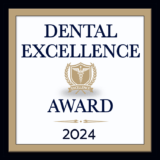Have you ever been apprehensive about needing teeth removed or witnessed a family member experience tooth extraction? If so, you should be aware of dry socket and how to prevent it. It is a potential condition that can follow tooth extraction causing unnecessary pain and discomfort. We hope that this article will provide you with a sensible understanding of what dry socket is and its causes. You will also become more familiar with its symptoms and proactive ways to prevent its development!
So, what is Dry Socket?
Imagine that one of your teeth has just been removed. Normally, as the healing process begins, a blood clot formulates at the exact spot the tooth was extracted. You start to experience relief because the blood clot forms and remains in your removal site. The blood clot is in place of the roots that once resided there in your mouth, supporting the soft and hard tissues to heal smoothly. This gives you relief, and your dentist reminds you of the importance of keeping the clot intact for a successful healing process.
Why is that significant? If the clot comes out of the site or dissolves before the healing process is complete, this can lead to the unsavory dry socket condition. Unfortunately, this condition causes prolonged pain, swelling, and irritation, delaying the typical healing process. Keep in mind, increased pain will usually begin within 1-5 days of your tooth extraction. Also, the extraction site will be more susceptible to infection. Your goal is to stay healthy! So, you are probably wondering what causes Dry Socket.
Causes and Risk Factors of Dry Socket
Some of the most likely causes of this condition can be attributed to the following factors:
- Bacteria that infiltrates the extraction site.
- Jawbone complications.
- Trauma or injury at the removal site.
The following risk factors can enhance your chances of developing dry socket:
- Birth control pills.
- Poor overall dental hygiene.
- Smoking and tobacco usage.
- Present or past infections around the site.
Be on the Lookout: Common Dry Socket Symptoms
Keep a keen eye out for pain and swelling as they are the most common symptoms of Dry Socket. However, the following symptoms listed below might accompany the undesirable pain and swelling.
- Bad breath or unfavorable taste in your mouth.
- A visible bone that is clearly seen in the socket.
- An empty socket if the blood clot dissolved.
- Pain that pulsates throughout your head and face; typically on the same side as the site of tooth removal.
What are some ways to prevent this condition from developing?
Before Surgery:
Exercise Outstanding Dental Care Techniques: It’s imperative that you practice superb dental care before your surgery date. Are you brushing twice a day and flossing once a day? If not, start now, because maintaining optimal oral hygiene will keep your teeth + gums bacteria free and fresh!
No Smoking Allowed: Please remember to lay off the tobacco products and smoking before your important day. Clear your mouth of these contaminants so you can decrease your chances of getting a dry socket. You’ll be happy you did!
Who Is Your Surgeon? Did you do your research when searching for a reputable dental professional? Hopefully, you have discovered a knowledgeable expertise in the field. Extracting teeth is challenging and requires an experienced dentist or oral surgeon.
What Medications Are You Currently Taking? Discuss with your oral surgeon any potential medications that you currently take just in case they are cause for concern. Specific herbs and medications can interfere with the blood clotting process after your tooth has been removed.
After Surgery
- Hydrate Your Body with H2O! Be prepared to hydrate your body with plenty of water after this procedure! It will be wise of you to stay away from all other types of beverages except water. Yes, this includes caffeine, carbonation, and hot drinks. Don’t worry, this is only temporary! Most importantly, please stay away from straws as any sort of suction could disrupt the healing process and ruin the blood clot.
- What Can You Eat? Be mindful of your cheeks and lips as the numbing decreases after extraction. Chewing on anything while you’re still partially numb could cause you to bite your lips or cheeks. You want less pain not more! Once you are able to eat joyfully, pick soft foods, at-least for the first day. Try and consume foods that do not require so much chewing. And for goodness sake, remember to chew on the non-surgery side of your mouth.
- Cold and Warm Packs: After your surgery, apply a cold pack to help with any pain and swelling. Warm packs have also been known to help after the first few days.
- Is Brushing After Surgery Recommended? It is okay to brush gently and rinse after surgery. However, stay clear of the extraction site for the first 24 hours. After the first day, you can also rinse your mouth with warm salt water multiple times daily for a week.
Empower Your Dental Journey with Expert Guidance and Support!
We hope that this article has provided a well-rounded understanding of dry socket and its causes, risk factors, symptoms, and prevention. This condition is unpleasant, but there are a multitude of ways to prepare yourself before surgery, and techniques you can utilize to expedite the healing process after surgery. Please feel free to reach out to Shorewood Family Dental Care at 815-725-5991 for more information about your Dental Health! We truly look forward to hearing from you!





